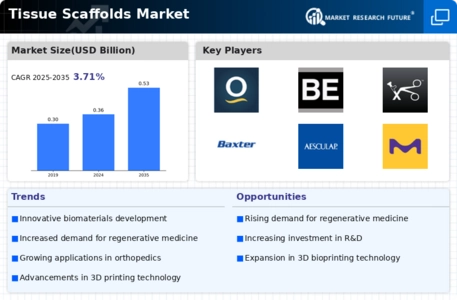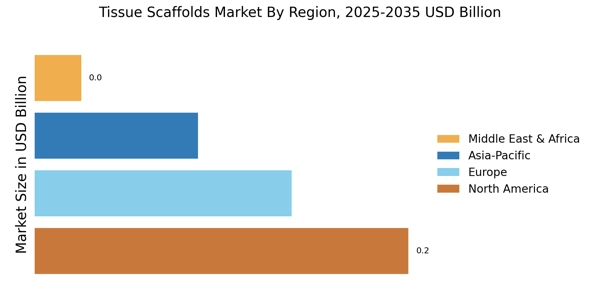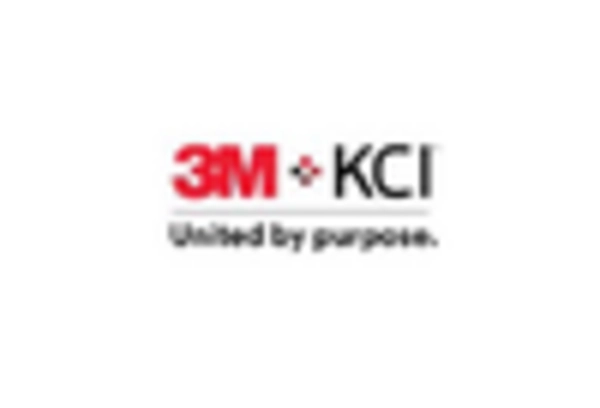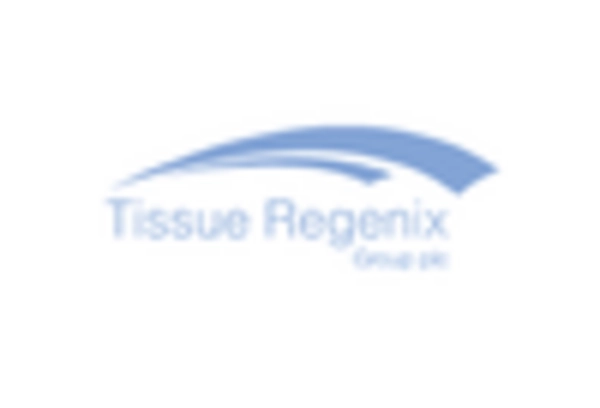Rising Demand for Regenerative Medicine
The Tissue Scaffolds Market is experiencing a notable surge in demand due to the increasing focus on regenerative medicine. This sector aims to restore or replace damaged tissues and organs, which has become a priority in healthcare. As of 2025, the market for regenerative medicine is projected to reach approximately 50 billion USD, indicating a robust growth trajectory. Tissue scaffolds play a crucial role in this field by providing a supportive structure for cell attachment and growth. The integration of advanced biomaterials enhances the efficacy of these scaffolds, making them indispensable in tissue engineering applications. Furthermore, the rising prevalence of chronic diseases and the aging population are likely to drive the need for innovative solutions in tissue repair and regeneration, thereby propelling the Tissue Scaffolds Market forward.
Regulatory Support and Approval Processes
Regulatory support plays a pivotal role in shaping the Tissue Scaffolds Market. As governments and regulatory bodies establish clearer guidelines for the approval of tissue-engineered products, the pathway to market entry becomes more streamlined. This regulatory clarity is essential for fostering innovation and encouraging investment in the development of new scaffolds. In 2025, it is anticipated that the approval processes for tissue scaffolds will become more efficient, potentially reducing the time required for new products to reach the market. This supportive regulatory environment is likely to enhance the confidence of manufacturers and investors, thereby stimulating growth in the Tissue Scaffolds Market. As a result, the industry may witness an influx of novel products that meet the evolving needs of healthcare providers and patients.
Growing Awareness of Personalized Medicine
The Tissue Scaffolds Market is benefiting from the growing awareness and adoption of personalized medicine. This approach tailors medical treatment to individual characteristics, needs, and preferences, which is particularly relevant in tissue engineering. As healthcare providers increasingly recognize the importance of personalized solutions, the demand for customized tissue scaffolds is likely to rise. By 2025, the market for personalized medicine is projected to reach approximately 100 billion USD, indicating a substantial opportunity for tissue scaffold manufacturers. The ability to create scaffolds that cater to specific patient profiles enhances treatment outcomes and patient satisfaction. Consequently, this trend is expected to drive innovation and growth within the Tissue Scaffolds Market.
Technological Innovations in Scaffold Design
Technological advancements are significantly influencing the Tissue Scaffolds Market, particularly in scaffold design and fabrication techniques. Innovations such as electrospinning and 3D bioprinting are revolutionizing the way scaffolds are created, allowing for more precise control over their architecture and properties. These technologies enable the production of scaffolds that closely mimic the natural extracellular matrix, which is essential for effective tissue regeneration. As of 2025, the market for 3D bioprinting in tissue engineering is expected to grow at a compound annual growth rate of over 25%. This rapid growth suggests that the integration of cutting-edge technologies will continue to enhance the functionality and applicability of tissue scaffolds, thereby expanding their use in clinical settings.
Increasing Investment in Research and Development
Investment in research and development is a critical driver for the Tissue Scaffolds Market. As stakeholders recognize the potential of tissue engineering, funding for R&D initiatives has seen a marked increase. In 2025, it is estimated that global investments in tissue engineering research will exceed 10 billion USD. This influx of capital is likely to accelerate the development of novel scaffolding materials and techniques, fostering innovation within the industry. Furthermore, collaborations between academic institutions and industry players are becoming more prevalent, facilitating the translation of research findings into practical applications. This trend not only enhances the quality of tissue scaffolds but also broadens their potential applications in regenerative medicine, thus driving market growth.

















